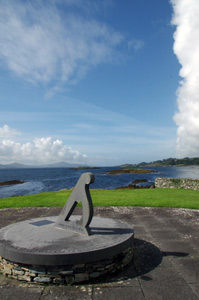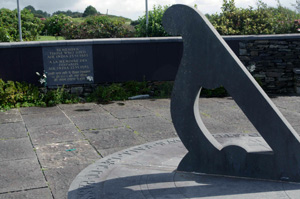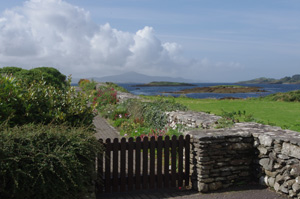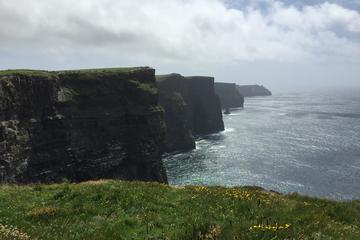
The Air India Disaster: Ahakista, West Cork, Ireland
by Anna Marie D’Angelo
In a tiny village in southwest Ireland on the Atlantic is a memorial to the victims of the Air India bombing, Canada’s worst mass murder terrorist attack.
The memorial in West Cork’s tiny Ahakista village to 329 people who died on June 23, 1985 doesn’t seem to be known to many people in Ireland where tragedies are forever remembered in bronze works such as the Famine Memorial in Dublin.
 Visiting the Air India memorial is not easy, and the usual response from people in Ireland was “never heard of it” and occasionally, “I remember something about that. When did it happen?” The memorial is not on any tour route nor do tour buses get close so I organized my visit through the hotel in Killarney where I was staying. Killarney is the largest town in the area and a major southern Ireland tourist spot. A local cabbie, who does customized tours, offered a flat rate for the day. The other option, and cheaper choice, would have been to rent a car.
Visiting the Air India memorial is not easy, and the usual response from people in Ireland was “never heard of it” and occasionally, “I remember something about that. When did it happen?” The memorial is not on any tour route nor do tour buses get close so I organized my visit through the hotel in Killarney where I was staying. Killarney is the largest town in the area and a major southern Ireland tourist spot. A local cabbie, who does customized tours, offered a flat rate for the day. The other option, and cheaper choice, would have been to rent a car.
On this August day, it had rained in the morning as it did almost everyday during my three-week stay in the Emerald Isle. But the sky soon opened up to brilliant warm sunshine shortly after we started the 1-1/2 hour drive.
We headed southeast along a portion of the beautiful Ring of Kerry route, on windy roads next to hills with scenic vistas of patchwork green valleys, edging the sparkling Atlantic. We travelled through the charming small towns of Kenmare, Glangariff and Bantry and on to Ahakista, which is on the Sheep Head’s peninsula in West Cork.
The trip was not for the faint at heart. Even with an experienced driver at the wheel, we had three close calls where the cabbie abruptly steered towards the edge of the road and slammed on the brakes to avoid an on-coming car visible in the tall greenery at the last minute. Driving in Ireland is on the left side and these roads were narrow with poor visibility.
When we finally arrived at the remote village, we drove past the small “Air Disaster Memorial” sign without noticing. Knowing that we had gone too far as in, next stop the Atlantic, we flagged a truck driver hauling a huge steel tank. He was slowly making his way around, picking up milk from farms. “The Air India one?” he immediately responded. “Go back up the road.”
Two Dubliners were walking down the path from the memorial. They said they saw the sign and remembered the tragedy from news reports. They acknowledged it was a nice tribute to the bombing victims.
 The memorial includes a well kept with a sundial that commemorates the day and hour of jumbo jet’s explosion in the air. There is a low, stone, semi-circle wall with the names of the victims that appears to cup the sundial. (Picture 4)A tidy garden maintained by the village borders the path to the memorial, which is oriented towards the breezy, wide-open ocean.
The memorial includes a well kept with a sundial that commemorates the day and hour of jumbo jet’s explosion in the air. There is a low, stone, semi-circle wall with the names of the victims that appears to cup the sundial. (Picture 4)A tidy garden maintained by the village borders the path to the memorial, which is oriented towards the breezy, wide-open ocean.
After visiting this quiet, serene place, I checked out the wee village and its rustic Catholic church. Driver Moses Walsh took us back to Killarney along a different route, through the serpentine Healy Pass, where buses can’t travel. The pass is yet another route with hilly, seaside vistas that are amazing.
 At one point, we had to stop for a flock of sheep across the road which gave the weathered sheepherder time to walk up to the van. He quickly fired off about a dozen personal questions in a sing-songy Irish accent including asking where were we from, where were we going and was I married. Driver Walsh had predicted we were going to be there a long time when the sheepherder headed towards us. Walsh was greatly relieved when another car came around the bend and the sheepherder had new people to question.
At one point, we had to stop for a flock of sheep across the road which gave the weathered sheepherder time to walk up to the van. He quickly fired off about a dozen personal questions in a sing-songy Irish accent including asking where were we from, where were we going and was I married. Driver Walsh had predicted we were going to be there a long time when the sheepherder headed towards us. Walsh was greatly relieved when another car came around the bend and the sheepherder had new people to question.
We continued along a portion of the equally beautiful Beara Peninsula. The relaxing day was rounded out with lunch at pub in the village of Glengarriff and visits to popular tourist stops: Killarney National Park with its impressive waterfall, and to Muckross House and Gardens, a Victorian mansion.
Background on the Air India Disaster
Air India Flight 182 departed from Vancouver to Toronto on the way to New Delhi and exploded in the air over Ireland on June 23, 1985, killing all 329 people on board. A huge search was carried out and half the bodies were recovered and taken ashore in Cork. The memorial in Ahakista was built a year later. No one has been convicted of this terrorist act, allegedly committed by Sikh extremists. [UPDATE: In 2003 Inderjit Singh Reyat, pleaded guilty to manslaughter and was sentenced to fifteen years in prison for assembling the bombs.]
If You Go:
♦ Killarney is the main city in the area which is famous for its lakes, mountains and scenic drives such as the Ring of Kerry.
♦ Killarney is a 4½ hour drive from Dublin. The train takes 3 ½ hours.
♦ To hire a taxi-van and driver for one day for a customized tour of the area costs from 180 to 240 euros ($225 – $300). The van holds seven passengers.
Tours from Killarney:
Dingle and Slea Head Day Tour from Killarney
Ring of Kerry and Skellig Experience Centre Day Trip from Killarney

Cliffs of Moher Private Tour from Killarney
About the author:
Anna Marie was a successful newspaper reporter and editor in the Vancouver area for 18 years. She now does Communications work and continues her writing passion through travel stories that have been published in major newspapers across Canada. Email: anna_dangelo@hotmail.com
All photos are by Anna Marie D’Angelo.



Leave a Reply
You must be logged in to post a comment.